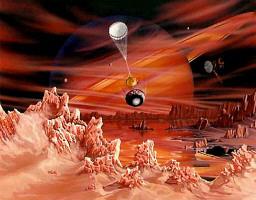The Cassini space probe has found an underground ocean on Titan, the largest and most mysterious moon of Saturn.
The presence of water on Titan could mean there are conditions for life there, the Italian Space Agency (ASI) said. ''This is a scientific result of the first order,'' said ASI's space exploration chief Enrico Flamini.
''If there is water on Titan, it is important to study it to see if there are the basic conditions for the formation of organic molecules''.
ASI works on the Cassini probe with NASA and the European Space Agency.
The spacecraft's full name is the Cassini-Huygens probe - the surnames of two historically important astronomers. Flamini noted that Titan was now the third body in the Solar System where a huge water mass has been found under the surface.
The other two with underground oceans are Saturn's sixth-largest moon, Enceladus, and Europa, the sixth moon of Jupiter. ''Once again, the radar built by ASI has proved itself an essential instrument in the ongoing discovery of Titan,'' Flamini said.
Data from the radar were processed in Italy by Luciani Iess and Paolo Persi of Rome university.
They reckon the ocean could contain minute amounts of methane and ammonia, but is ''essentially 99% water''.
The probe did not actually 'see' the water under Titan's surface but basically determined it must be there because of a huge variation in Titan's movement, Flamini explained.
''Titan's internal structure was detected through extremely precise and complex calculations.
''We found that the only thing that could be slowing down the moon's rotation was an ocean acting as a buffer between Titan's icy crust and its core''. The Cassini-Huygens space probe began its four-year sweep of Titan in January 2005, sending back the first data on an atmosphere resembling Earth's when life began.
The probe was the first man-made device to encounter the moon - and the first to orbit Saturn.
During its visit to Saturn, in which scientists have learned much more about how the Solar System formed, the probe has provided key information about what Saturn is made of.
It has scanned its stormy atmosphere, molten core and mysterious rings, believed to be the remains of pulverised moons, asteroids and comets.
Among its most recent discoveries, it has found evidence of material orbiting Rhea, Saturn's second largest moon. It was the first time traces of rings have been found around a moon. Last week Cassini performed a daring flyby of Enceladus, flying about 15 kilometers per second (32,000 mph) through icy water geyser-like jets. The spacecraft snatched up precious samples that might point to a water ocean or organics inside the little moon. Among its other notable discoveries, Cassini found a huge methane gas lake on Titan in 2006 - making it the only place outside Earth known to have lakes.
The lake near Titan's south pole is about the size of Lake Ontario, ASI said.
Scientists think the lake may have been produced by a vulcanic eruption or the impact of an asteroid.
Before plunging into Titan's atmosphere, in a momentous moment for space discovery in October 2004, Cassini sent back the first pictures of the thick clouds surrounding the moon.
The images were picked up by a European Space Agency (ESA) station in Spain and relayed to NASA's Jet Propulsion Laboratory at Pasadena, Texas.
The probe was built by NASA, ESA and ASI.
ASI's Visual and Infrared Mapping Spectrometer (VIMS) has so far been crucial in collecting data.
The VIMS, a kind of ultra-advanced radar, has been able to pierce the dense mists enveloping Titan.
Titan is the primary objective of the Cassini mission because it is the only moon in the Solar System with a dense atmosphere - believed to be similar to the one initially formed when the Earth came into being.
The $3.3bn probe - the third-largest space exploration craft ever built, behind two Soviet probes - covered over three billion km in its seven-year mission to the sixth planet.
The mission will continue to study Saturn and its 31 known moons for another year.
None of the three probes which preceded Cassini-Huygens - Pioneer in 1979, Voyager 1 in 1980 and Voyager 2 in 1981 - got anywhere near as close as this one.
The spacecraft and probe are named after the 17th-century astronomers Giovanni Domenico (Jean-Domenique) Cassini of Italy, who set up the Paris Observatory in 1671 and became astronomer to Louis XVI, and his collaborator Christiaan Huygens of the Netherlands, a symbol of the scientific revolution.
Seventeen nations contributed to building Cassini-Huygens. The Cassini orbiter was built and managed by the Jet Propulsion Laboratory, the Huygens probe was built by ESA, and ASI provided Cassini's high-gain communication antenna. More than 250 scientists worldwide are studying the data streaming back from Saturn on a daily basis. photo: CGI-generated artist's impression of probe sweeping Titan













